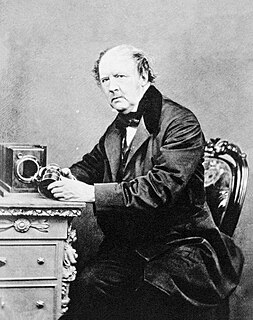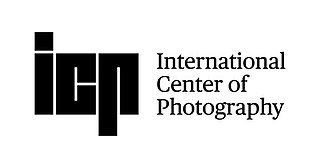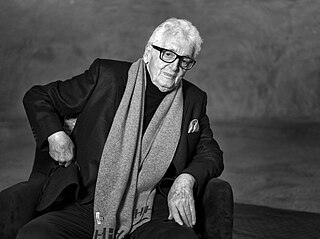
Calotype or talbotype is an early photographic process introduced in 1841 by William Henry Fox Talbot, using paper coated with silver iodide. Paper texture effects in calotype photography limit the ability of this early process to record low contrast details and textures. The term calotype comes from the Ancient Greek καλός, "beautiful", and τύπος, "impression".

Photojournalism is journalism that uses images to tell a news story. It usually only refers to still images, but can also refer to video used in broadcast journalism. Photojournalism is distinguished from other close branches of photography by having a rigid ethical framework which demands an honest but impartial approach that tells a story in strictly journalistic terms. Photojournalists contribute to the news media, and help communities connect with one other. They must be well-informed and knowledgeable, and are able to deliver news in a creative manner that is both informative and entertaining.

A tintype, also known as a melainotype or ferrotype, is a photograph made by creating a direct positive on a thin sheet of metal coated with a dark lacquer or enamel and used as the support for the photographic emulsion. Tintypes enjoyed their widest use during the 1860s and 1870s, but lesser use of the medium persisted into the early 20th century and it has been revived as a novelty and fine art form in the 21st.

The International Center of Photography (ICP), in the Lower East Side of Manhattan, New York City, consists of a museum for photography and visual culture and a school offering an array of educational courses and programming. ICP's photographic collection, reading room, and archives are at Mana Contemporary in Jersey City, New Jersey. The organization was founded by Cornell Capa in 1974.

Mary Ellen Mark was an American photographer known for her photojournalism, documentary photography, portraiture, and advertising photography. She photographed people who were "away from mainstream society and toward its more interesting, often troubled fringes".
Frank Gohlke is an American landscape photographer. He has been awarded two Guggenheim fellowships, two fellowships from the National Endowment for the Arts, and a Fulbright Scholar Grant. His work is included in numerous permanent collections, including those of Museum of Modern Art, New York; the Metropolitan Museum of Art; and the Art Institute of Chicago.

Fine-art photography is photography created in line with the vision of the photographer as artist, using photography as a medium for creative expression. The goal of fine-art photography is to express an idea, a message, or an emotion. This stands in contrast to representational photography, such as photojournalism, which provides a documentary visual account of specific subjects and events, literally representing objective reality rather than the subjective intent of the photographer; and commercial photography, the primary focus of which is to advertise products, or services.
Documentary photography usually refers to a popular form of photography used to chronicle events or environments both significant and relevant to history and historical events as well as everyday life. It is typically undertaken as professional photojournalism, or real life reportage, but it may also be an amateur, artistic, or academic pursuit.

Esther Bubley was an American photographer who specialized in expressive photos of ordinary people in everyday lives. She worked for several agencies of the American government and her work also featured in several news and photographic magazines.

Harry James Benson is a Scottish photographer. His photographs of celebrities have been published in magazines. He has published several books and won a number of prominent awards.

Nature photography is a wide range of photography taken outdoors and devoted to displaying natural elements such as landscapes, wildlife, plants, and close-ups of natural scenes and textures. Nature photography tends to put a stronger emphasis on the aesthetic value of the photo than other photography genres, such as photojournalism and documentary photography.
Black Star, also known as Black Star Publishing Company, was started by refugees from Germany who had established photographic agencies there in the 1930s. Today it is a New York City-based photographic agency with offices in London and in White Plains, New York. It is known for photojournalism, corporate assignment photography and stock photography services worldwide. It is noted for its contribution to the history of photojournalism in the United States. It was the first privately owned picture agency in the United States, and introduced numerous new techniques in photography and illustrated journalism. The agency was closely identified with Henry Luce's magazines Life and Time.
Linda Connor is an American photographer living in San Francisco, California. She is known for her landscape photography.

Grant Mudford, is an Australian photographer.
Mario Algaze is a Cuban-American photographer.
Ellis (Eli) Reed is an American photographer and photojournalist. Reed was the first full-time black photographer employed by Magnum Agency and the author of several books, including Black In America. Several of the photographs from that project have been recognized in juried shows and exhibitions.
Andrea Modica is an American photographer and professor of photography at Drexel University. She is known for portrait photography and for her use of platinum printing, created using an 8"x10" large format camera. Modica is the author of many monographs, including Treadwell (1996) and Barbara (2002).
Patrick Farrell is a Pulitzer Prize-winning American photojournalist for the Miami Herald.
Anthony Hernandez is an American photographer who divides his time between Los Angeles, his birthplace, and Idaho. His photography has ranged from street photography to images of the built environment and other remains of civilization, particularly those discarded or abandoned elements that serve as evidence of human presence. He has spent most of his career photographing in Los Angeles and environs. "It is L.A.'s combination of beauty and brutality that has always intrigued Hernandez." La Biennale di Venezia said of Hernandez, "For the past three decades a prevalent question has troubled the photographer: how to picture the contemporary ruins of the city and the harsh impact of urban life on its less advantaged citizens?" His wife is the novelist Judith Freeman.
Brenda Ann Kenneally is an American photojournalist and documentary photographer, specializing in social causes and the illegal drug economy. Her work has been featured in the NYT Magazine, Rolling Stone, and Ms. She won the 2000 Community Awareness Award from the National Press Photographer's Association, and the 2001 International Prize for Photojournalism. She is a Guggenheim Fellow, Pulitzer Prize nominee, and formerly incarcerated and homeless youth. Kenneally is the founder of A Little Creative Class, a non-profit art organization that works to address the obstacles that deter poor and low-income youth from participation in art and the emerging idea-based economy.










